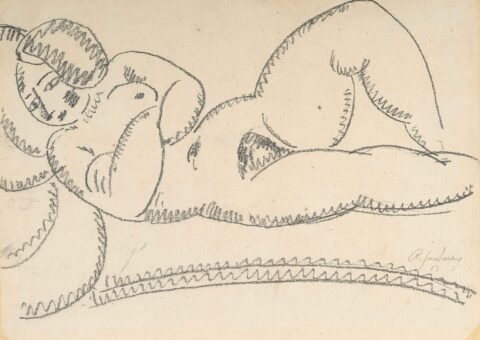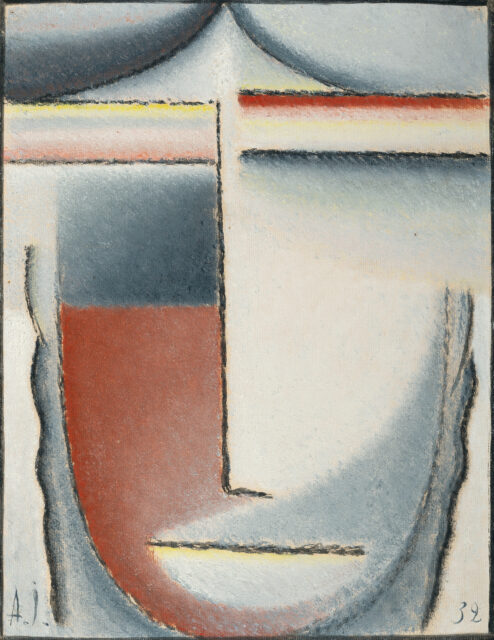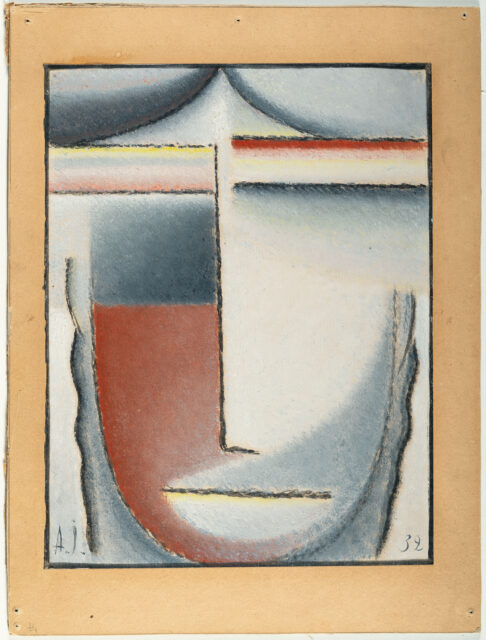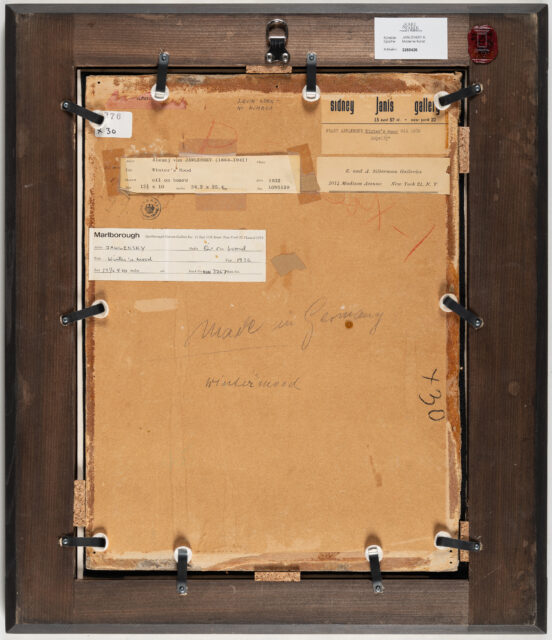
Abstract head: Winter mood
Details
Literature:
Weiler, Clemens, Alexej Jawlensky, Cologne 1959, no. 360, no illustration.
Exhibition:
Deutscher Künstlerbund, Städtische Kunsthalle, Königsberg/Museum Danzig 1932, cat. no. 157;
Deutscher Künstlerbund, Kunsthalle, Kiel 1933, no cat;
Homage to Jawlensky. Retrospective, Nierendorf Gallery, New York 1939, cat. no. 59;
Alexej von Jawlensky, Sidney Janis Gallery, New York 1957, cat. no. 45, on the reverse with the label;
18th, 19th, 20th Century Paintings, Joe and Emily Lowe Art Gallery, University of Miami, Coral Gables/Florida 1962;
Artist and Maecenas. A Tribute to Curt Valentin, Marlborough-Gerson Gallery, New York 1963, no cat., on the reverse with the label;
Masterpieces IV: Works of German Expressionism, Galerie Thomas, Munich 2008, with col. illus. p. 73;
3rd Art Dubai, Galerie Thomas, Madinat Arena, Dubai 2009, p. 34, with illus;
Alexej von Jawlensky, Galerie Thomas, Munich 2015/16, with col. illus. pp. 62 and 114.
Provenance:
Galka Scheyer (1889-1945), Hollywood/Los Angeles, since 1933 on commission directly from the artist, 1945-1954 Galka Scheyer estate;
Audrey Lowe Levin Collection, St. Louis/Missouri, acquired in 1954 from the aforementioned estate;
Sam J. Levin Collection, St. Louis, Missouri, 1991 by
Inheritance from the aforementioned;
Estate of Sam J. Levin and Audrey Lowe Levin, St. Louis, Missouri (1992);
Sotheby’s, New York 25 February 1992, lot 30;
Private collection, USA;
Galerie Thomas, Munich, since 2008;
Private collection, Berlin, since 2019;
Private collection, Switzerland, since 2021.
Descrizione
– Harmoniously balanced composition from the famous “Abstract Heads” group of works with a fine, wintery-cool colour spectrum
– The painting comes from the estate of the art dealer Galka Scheyer, who campaigned tirelessly for the artists of the “Blue Four” in the USA for over two decades
– The painting has already been shown in numerous exhibitions and impresses with its interesting international provenance
From 1914 onwards, Alexej von Jawlensky’s artistic development took an increasingly clear turn towards abstraction. He gradually reduced the motifs to a few basic patterns, which he varied again and again. The “Abstract Heads” series is a copy of this, in which he arrived at stylised, almost abstract human faces. The faces are constructed with only a few, but very characteristic lines. Their expression seems introverted, the either very light or muted dark colour palette underlines the meditative mood. The reference to old Russian icon painting is obvious, especially for someone as deeply religious as Jawlensky was.
In addition to his artistic endeavours to condense and reduce, his state of health also forced him to adopt a more static style of painting. From the end of the 1920s, painting became increasingly difficult for the almost seventy-year-old artist. He suffered from arthritis with considerable signs of paralysis in his hands and knee joints; his mobility was greatly reduced and associated with great pain. But Jawlensky would not be deterred from painting. As he himself says: “I sit and work. These are my favourite hours. I work for myself, just for myself and my God. I often feel faint with pain. But my work is a prayer, but a passionate prayer spoken through colours.” (quoted from: Clemens Weiler, Alexej Jawlensky, Cologne 1959, p. 126).
Jawlensky developed his own method in order to be able to continue working despite the progressive stiffening of his fingers. On smaller cardboard or paper formats, he created motifs reduced to the essentials, increasingly using the simplest artistic means. In doing so, he returned to the two genres of portraits and floral still lifes that had already characterised his oeuvre for years and was thus able to produce an astonishingly large number of small-format works until his complete paralysis in 1938. His long-time companions Wassily Kandinsky, Paul Klee and Karl Schmidt-Rottluff were also extremely enthusiastic about the heads, which ultimately represented the quintessence of his oeuvre, and acquired copies for their private collections.
When the National Socialists seized power in 1933, Jawlensky was finally forced to retreat into the private sphere. He was banned from exhibiting, his works were confiscated from museums and defamed at the National Socialist propaganda exhibition “Degenerate Art”. During this difficult time, Galka Scheyer, who had been working as an agent in America since 1924, was an important source of support for the artist. He sent her the “Abstract Head: Winter Mood” to Los Angeles on commission in 1933. The English inscription “made in Germany, Winter’s mood” on the reverse also comes from her. Galka Scheyer had made it her life’s work to popularise the art of Jawlensky, Wassily Kandinsky, Lyonel Feininger and Paul Klee in America. Under the name she coined “The Blue Four” – in reference to the “Blue Rider” – she worked tirelessly for over twenty years to win new buyers and collectors for the artists she admired. She raves about Jawlensky’s abstract heads: “Jawlensky transposed the human head as such into a language of abstract life, lifting it out of its earthly existence in order to manifest the soul and the spirit. The new laws he found in the process are mathematical ones. (…) Architecture in the equilibrium of colours, music in the tonal rhythm of colours, dance as the line of colours, sculpture as the form of colours, poetry as the content or word of the proclamation of colours, but painting as a symphonic summary” (quoted from: op. cit., p. 106).
Titled “Winterstimmung” and dated by Galka Scheyer on the reverse (partly covered by label) and inscribed “Made in Germany” and “winter(‘s) mood”. On the reverse also a Wiesbaden customs stamp and a label of the E. and A. Silberman Galleries, New York.
The work is no. 4 on the list of paintings to be sent to Galka Scheyer in the USA, which was drawn up in March 1933. In the list of works kept by the artist and his secretary Lisa Kümmel in 1934, the so-called “Cahier Noir”, it is listed on page 54 and marked with the note that it was sent to Galka in the USA in July 1933.
Jawlensky/Pieroni-Jawlensky 1402.
* Tutte le informazioni includono la commissione a carico dell'acquirente (27%) senza IVA e senza garanzia. Salvo errori.
** Tutte le informazioni più la commissione a carico dell'acquirente e l'IVA e senza garanzia. Salvo errori.
*** Con riserva: L'offerta è stata accettata al di sotto del limite. L'acquisizione dell'opera potrebbe essere ancora possibile nella nostra vendita post-asta.
R = Le opere d'arte regolarmente tassate
N = Opere d'arte soggette a tassazione differenziata e provenienti da un paese non UE
Non è consentita la riproduzione e la distribuzione privata o commerciale di tutte le illustrazioni delle opere esposte nell'archivio della mostra e dell'asta. Tutti i diritti riservati.






